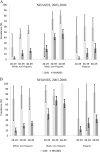Prevalence and risk factors associated with herpes simplex virus-2 infection in a contemporary cohort of HIV-infected persons in the United States
- PMID: 22249305
- PMCID: PMC5476946
- DOI: 10.1097/OLQ.0b013e318239d7fd
Prevalence and risk factors associated with herpes simplex virus-2 infection in a contemporary cohort of HIV-infected persons in the United States
Abstract
Background: We compared the herpes simplex virus type 2 (HSV-2) seroprevalence in a contemporary HIV cohort with the general US population and determined risk factors for HSV-2 infection among HIV-infected persons.
Methods: The Study to Understand the Natural History of HIV and AIDS in the Era of Effective Therapy (SUN) Study is a prospective observational cohort of 700 HIV-infected adults enrolled in 4 U.S. cities between 2004 and 2006. At baseline, participants completed a behavioral risk questionnaire and provided specimens for HSV-2 serology. We calculated HSV-2 seroprevalence, standardized by age, gender, and race among HIV-infected persons compared with the general US adult population, using data from the National Health and Nutrition Examination Survey from 2003 to 2006. We examined risk factors associated with HSV-2 infection among HIV-infected persons using multivariate logistic regression.
Results: Among 660 (94%) SUN participants with adequate specimens for HSV-2 serologic testing, 548 (83%) were 20 to 49 years old (median age, 39 years; 77% male; 59% non-Hispanic white; median CD4 count, 470 cells/mm; 74% with HIV RNA viral loads <400 copies/mL). HSV-2 seroprevalence was significantly higher among HIV-infected adults (59.7%, 95% confidence interval: 55.8-63.6) compared with the general US population (19.2%, 95% confidence interval: 17.5-21.1). In multivariate analysis, we found that older age, female gender, black non-Hispanic race/ethnicity, being currently unemployed, high-risk anal HPV infection, and longer duration since HIV diagnosis were associated with significantly higher odds of HSV-2 infection.
Conclusion: HSV-2 seroprevalence is 3 times as high among HIV-infected adults as in the general U.S. population. Clinicians should be aware that increased risk for HSV-2 infection was distributed broadly among HIV-infected persons and not limited to those with high-risk sexual behaviors.
Figures
References
-
- Fleming DT, McQuillan GM, Johnson RE, et al. Herpes simplex virus type 2 in the United States, 1976-1994. N Engl J Med. 1997;337:1105–1111. - PubMed
-
- Corey L. Synergistic copathogens—HIV-1 and HSV-2. N Engl J Med. 2007;356:854–856. - PubMed
-
- Hill C, McKinney E, Lowndes CM, et al. Epidemiology of herpes simplex virus types 2 and 1 amongst men who have sex with men attending sexual health clinics in England and Wales: Implications for HIV prevention and management. Euro Surveill. 2009;14:ii. 19418 Available at: http://www.eurosurveillance.org/ViewArticle.aspx?ArticleID=19418. - PubMed
-
- Romanowski B, Myziuk LN, Walmsley SL, et al. Seroprevalence and risk factors for herpes simplex virus infection in a population of HIV-infected patients in Canada. Sex Transm Dis. 2009;36:165–169. - PubMed
-
- Brown EL, Wald A, Hughes JP, et al. High risk of human immunodeficiency virus in men who have sex with men with herpes simplex virus type 2 in the EXPLORE study. Am J Epidemiol. 2006;164:733–741. - PubMed
Publication types
MeSH terms
Grants and funding
LinkOut - more resources
Full Text Sources
Other Literature Sources
Medical
Research Materials


